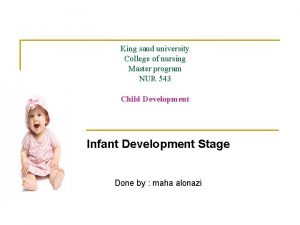College of Nursing Master Science in Nursing Program






















- Slides: 22

College of Nursing Master Science in Nursing Program NUR 500 - NURSING RESEARCH 1438 - 1439 H QUANTITATIVE RESEARCH DESIGN

RESEARCH DESIGNS Approach Types Qualitative (discovers) Phenomenological Grounded Theory Ethnography Design Qualitative OR Correlational Quantitative (describes) Descriptive Case study None experimental (observational) Quantitative (explains, causes & effect) Experimental Quasi- experimental

QUANTITATIVE RESEARCH • The investigation of phenomena that lend themselves to precise measurement and quantification , often involving a rigorous and controlled design. • Aim to elucidate cause- effect relationship. ( Pilot & Beck , 2017)

CAUSALITY Deterministic vs probabilistic causality • Probabilistic causation is when a cause increases the probability that its effect will occur (Parascandola & Weed, 2001) • A causes B: whenever A occurs, B occurs (deterministic). • A causes B: given A, the probability of B is greater than some criterion (probabilistic) • Counterfactuals: questions regarding what would have happened otherwise (never be realized) ( Pilot & Beck , 2017) P. 183

CRITERIA FOR CAUSALITY The challenge of quantitative research design is to facilitate inferences about causality : Ø Temporal Ø Relationship Ø No confounders ( Pilot & Beck , 2017) P. 184

Quantitative Research Designs Experimental research Quasi- experimental research design. Non- experimental research designs. Descriptive, survey, correlational, evaluative, methodological and content analysis studies

CHARACTERISTICS OF EXPERIMENTAL DESIGN: • Manipulation. • Control. • Randomization.

Manipulation. Researcher intentionally does something to study at least some participants - there is a some type of intervention • Example: • If the researcher want to investigate the effect of three different drugs (I. V. ) on the blood pressure. (D. V. ). He has to manipulate the drugs (drug a, b & c), as independent variables, and monitor the effect of each one on the B. P, the variable of interest.

Control. Holding constant possible influences on the dependent variable (D. V. ) under investigation. Such control is usually acquired by manipulation, use of control group, and careful preparation of the research plan. Control: control group is used to compare its performance with the treatment group on an outcome…(proxy of counterfactual) Alternative intervention, standard method of care, placebo, different intensity, wait-list

RANDOMIZATION • Randomization: random allocation or matching to minimize systematic bias by having equalization “Matching is problematic? ” Flip a coin… Use of random table…Use of computers. Allocation concealment…. SNOSE (sequentially numbered opaque sealed envelop) • Masking or Blinding: single blind or double blind…minimize expectation bias, performance bias N. B : random selection vs. random assignments

SPECIFIC EXPERIMENTAL DESIGNS • Basic experimental designs • Factorial design • Crossover design

BASIC EXPERIMENTAL DESIGNS • Pretest-posttest experimental design ( before – after design ) • Post-test design ( after-only design ) Example of Pretest-posttest experimental design: ( Pilot & Beck , 2017) P. 193

FACTORIAL DESIGN • Factorial design: evaluate the effectiveness of more than one intervention …. Factors are independent variables • 2× 2 factorial design evaluating two interventions against control (learning health information intervention encompasses noise and interruption) • 2× 2× 2 factorial design evaluating three factors and each factor has two levels (e. g. weight loss intervention encompasses keeping food diary, increasing activity, and home visit). • Example of factorial design: ( Pilot & Beck , 2017) P. 195

CROSSOVER DESIGN Crossover design: subjects are exposed to more than one condition , administered in a randomized order , and thus , they serve as their own control • Counterbalancing • Carry over effects • Washout period Example of a crossover design: ( Pilot & Beck , 2017) P. 196

STRENGTH & LIMITATIONS OF EXPERIMENTAL DESIGN Strength: ØInfer causal relationship. Øgreater corroboration (confirmation) Limitation: Ø Ø Artificiality Train the clinical staff Researcher has little control Hawthorne effect

QAUSI-EXPERIMENTS Experiment without randomization Types of quasi-experimental research: ØNonequivalent control group pretest-posttest: ØNonequivalent control group posttest only: ØTime-Series design: ( Pilot & Beck , 2017) P. 201 ØPartially Randomized Patient Preference(PRPP): ( Pilot & Beck , 2017) P. 199 ( Pilot & Beck , 2017) P. 202

STRENGTH & LIMITATIONS OF QAUSI-EXPERIMENTS • Quasi-experiments are practical • Quasi-experiments have weak evidence of causality

NON-EXPERIMENTAL (OBSERVATIONAL) DESIGNS Non experimental=Observational research: NO manipulation 1 - Correlational cause- probing research ( Pilot & Beck , 2017. P. 204) ØRetrospective designs…. cross sectional: ( Pilot & Beck , 2017. P. 204) ØRetrospective case-control design: ØRetrospective designs for risk factors (amount of an outcome not cassenas) 2 - Prospective designs…. prospective: ØCohort: ØNatural Experiments: ØPath Analytic: ( Pilot & Beck , 2017) P. 205 ( Pilot & Beck , 2017. P. 205) ( Pilot & Beck , 2017. P. 206)

NON-EXPERIMENTAL (DESCRIPTIVE) DESIGNS Non experimental=descriptive research: observe ; describe; document 1 - Descriptive correlation studies: ( Pilot & Beck , 2017. P. 206) 2 - Univariate descriptive : a) prevalence studies b) incidence studies: ( Pilot & Beck , 2017. P. 207) 3 - Evaluation research: assesses how well a program , practice , or policy is working 4 - Methodologic study: develop or refine methods of obtaining, organizing or analyzing data

5. CONTENT ANALYSIS • Evaluation of a hypothesis using publicly available pictures and language • Manifest Content • Measures the frequency of some word, image, phrase, or action • Latent Content • • Measures the appearance of themes, as determined by the researcher Use at least two coders to increase reliablity

STRENGTH & WEAKNESS OF NONEXPERIMENTAL DESIGN Strength : üLarge amount of data üProvides base for experimental research üRealism Limitation : üCan not infer causation üMay include bias of selection üThe world is complex and related (always another explanation)

REFERENCES Polit, D. F. , & Beck, C. T. (2017). Nursing research: Generating and assessing evidence for nursing practice (10 th ed. ). Philadelphia: Lippincott. Center of innovation in research and teaching https: //cirt. gcu. edu/research/developmentresources/research_ready/qua ntresearch/data
 Wake tech admissions
Wake tech admissions What's your favourite subject
What's your favourite subject Lone star nursing requirements
Lone star nursing requirements Glendale nursing course
Glendale nursing course Montgomery college nursing
Montgomery college nursing Johnson county community college nursing program
Johnson county community college nursing program Sacramento city college nursing program
Sacramento city college nursing program Moraine valley nursing
Moraine valley nursing Nursing program montgomery college
Nursing program montgomery college Lane community college nursing
Lane community college nursing Cscc lpn program
Cscc lpn program Hesi lonestar
Hesi lonestar Master of professional studies in data science
Master of professional studies in data science Tor vergata business administration
Tor vergata business administration Thilo kielmann
Thilo kielmann Notre dame msm
Notre dame msm Osu beef cattle manual
Osu beef cattle manual Blue master program
Blue master program Early college high school at midland college
Early college high school at midland college Queens college of arts and science
Queens college of arts and science Queens college thanjavur
Queens college thanjavur Db science college gondia
Db science college gondia Bon secours arts and science college
Bon secours arts and science college











































